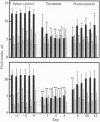Abstract
Syrian Golden hamsters prefer and consume large and remarkably constant amounts of ethanol in a simple two-bottle free-choice regimen. Ethanol intake is significantly suppressed by zimelidine, bromocriptine, buspirone, and lithium carbonate, pharmacological agents that have been shown to be beneficial in controlling ethanol intake in alcohol-dependent humans. These results suggest that this ethanol-drinking animal model has high "predictive validity" and can be used effectively in the search for and identification of new agents for the treatment of alcohol abuse. The model has enabled us to confirm the putative antidipsotropic effect of Radix puerariae (RP), an herb long used in traditional Chinese medicine for the treatment of patients who abuse alcohol. A crude extract of RP at a dose of 1.5 g.kg-1 x day-1 significantly suppresses (> 50%) the free-choice ethanol intake of Golden hamsters. Moreover, two major constituents of RP, daidzein (4',7-dihydroxyisoflavone) and daidzin (the 7-glucoside of daidzein), were also shown to suppress free-choice ethanol intake. Daidzin and daidzein, at doses of 150 and 230 mg.kg-1 x day-1, respectively, suppress ethanol intake by > 50%. RP, daidzein, and daidzin treatment do not significantly affect the body weight and water or food intake of the hamsters. These findings identify a class of compounds that offer promise as safe and effective therapeutic agents for alcohol abuse.
Full text
PDF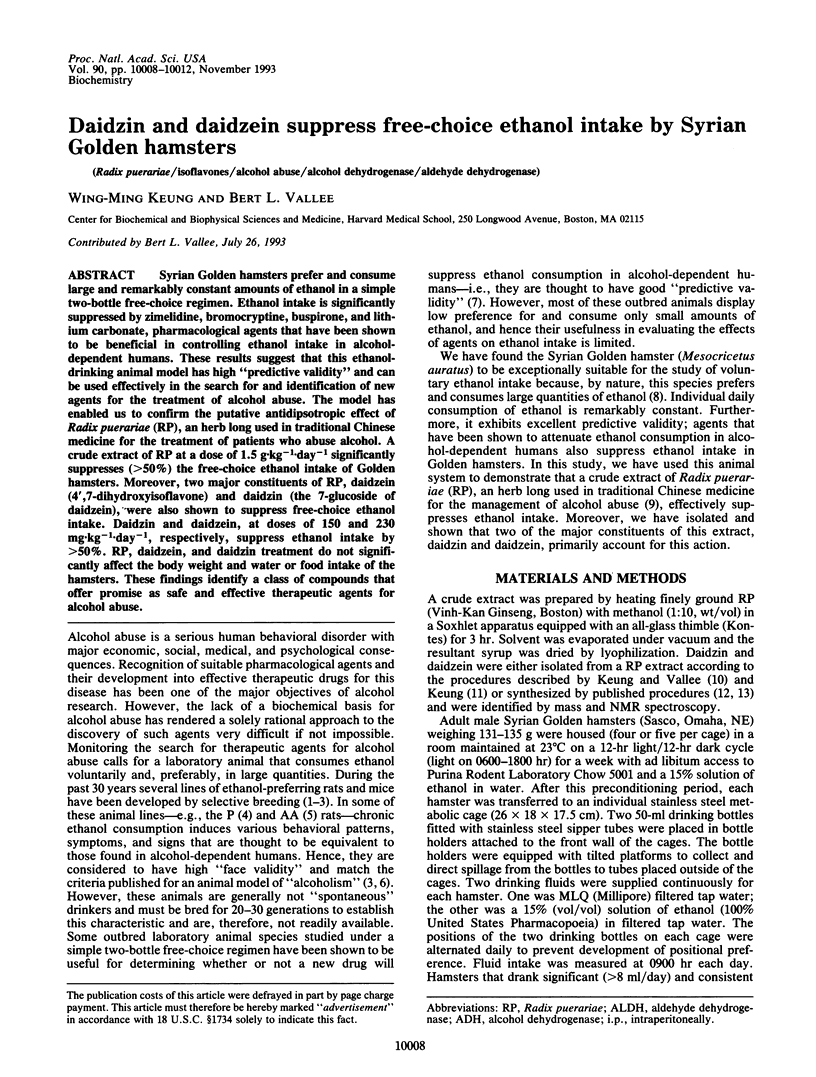
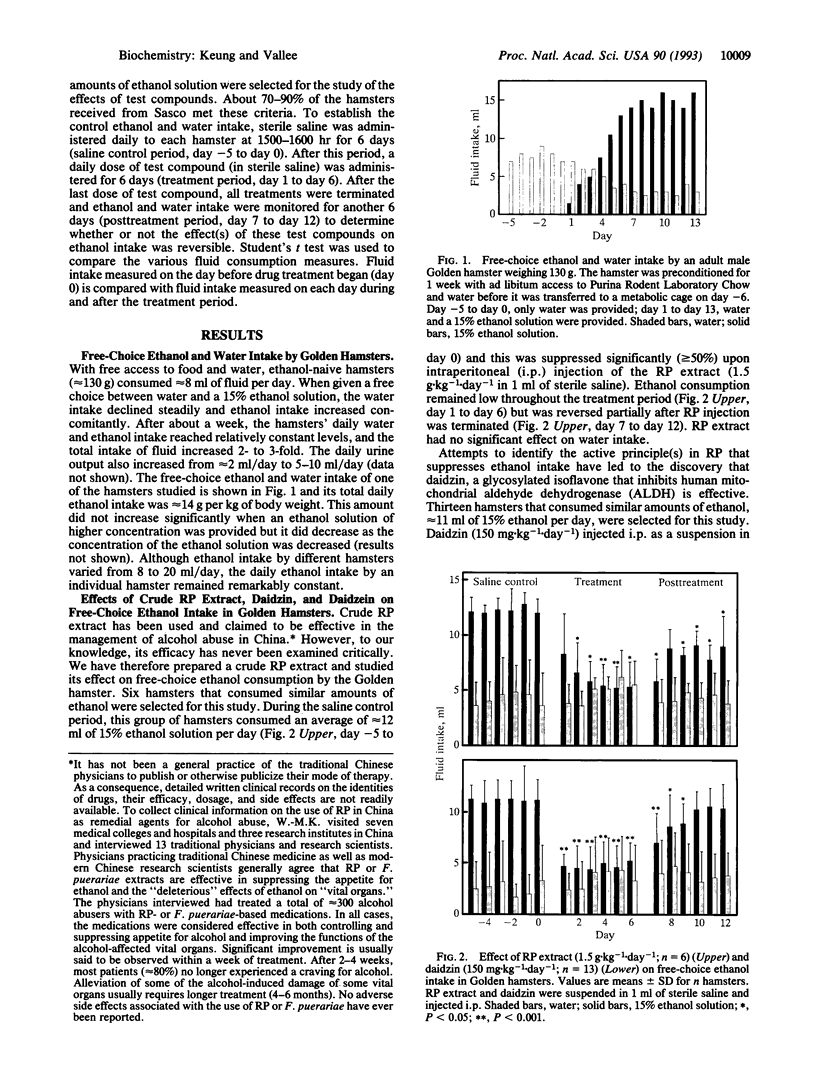
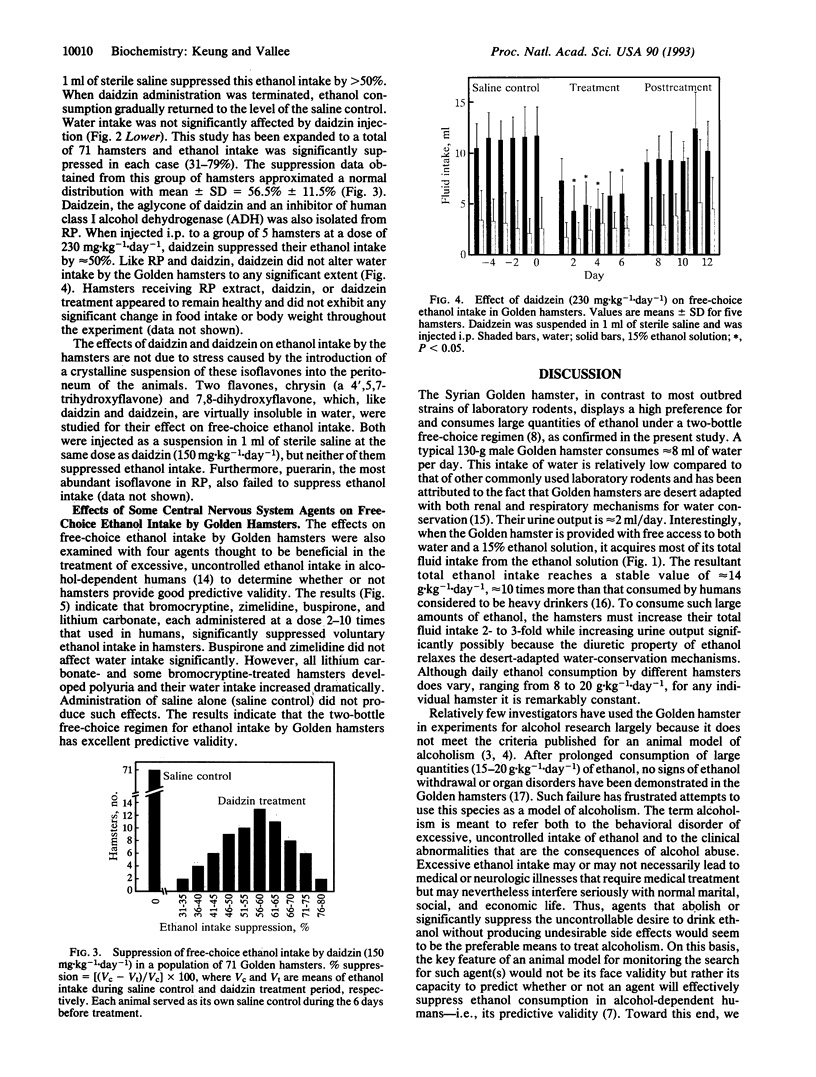
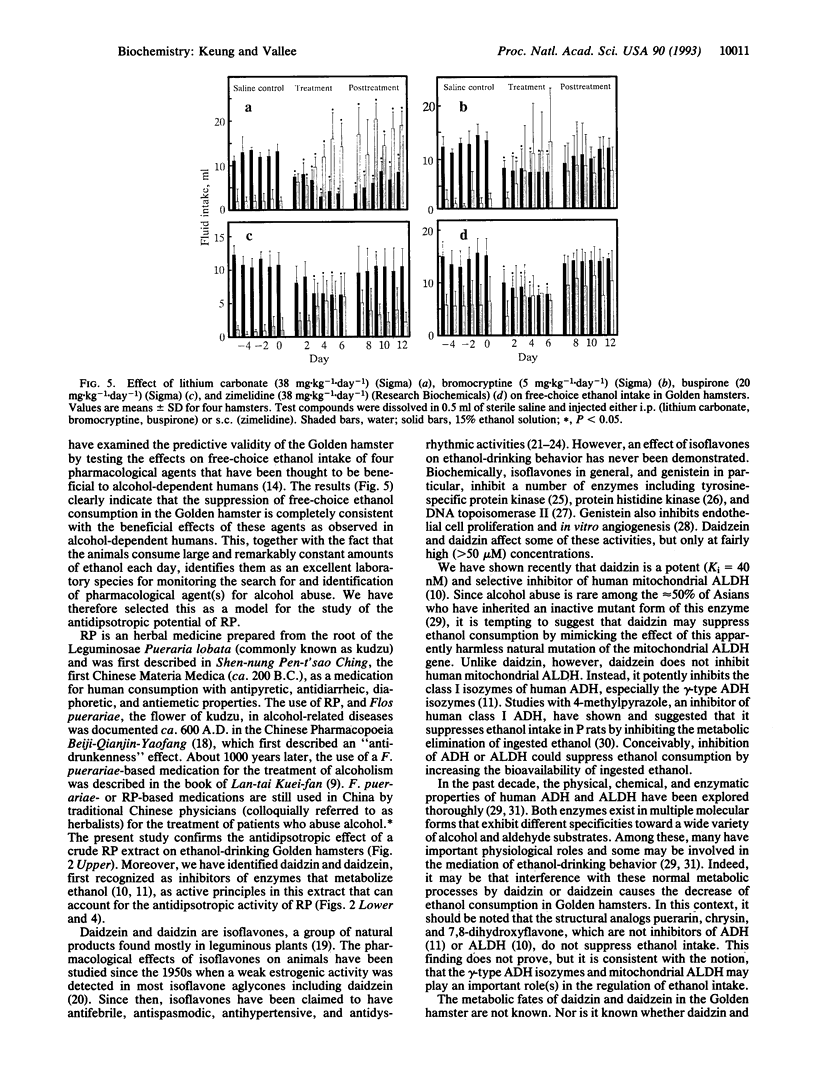
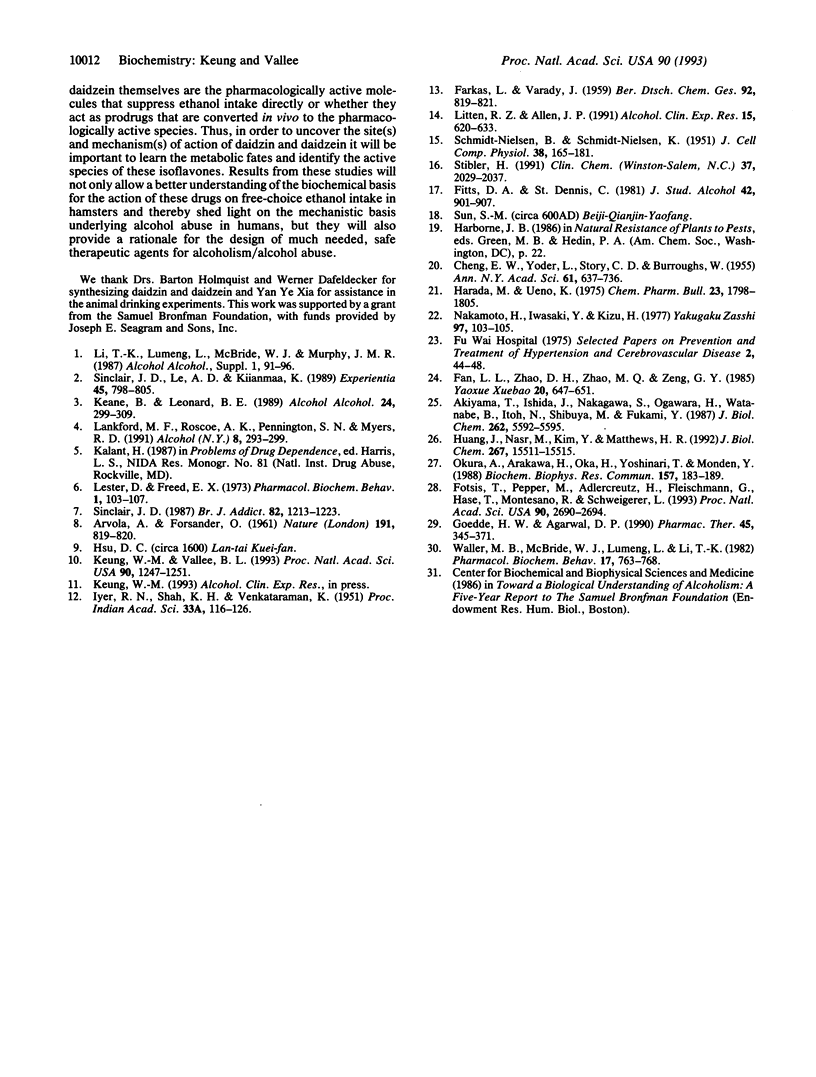
Images in this article
Selected References
These references are in PubMed. This may not be the complete list of references from this article.
- ARVOLA A., FORSANDER O. Comparison between water and alcohol consumption in six animal species infree choice experiments. Nature. 1961 Aug 19;191:819–820. doi: 10.1038/191819a0. [DOI] [PubMed] [Google Scholar]
- Akiyama T., Ishida J., Nakagawa S., Ogawara H., Watanabe S., Itoh N., Shibuya M., Fukami Y. Genistein, a specific inhibitor of tyrosine-specific protein kinases. J Biol Chem. 1987 Apr 25;262(12):5592–5595. [PubMed] [Google Scholar]
- Fan L. L., Zhao D. H., Zhao M. Q., Zeng G. Y. [The antidysrhythmic effect of puerariae isoflavones]. Yao Xue Xue Bao. 1985 Sep;20(9):647–651. [PubMed] [Google Scholar]
- Fitts D. A., St Dennis C. Ethanol and dextrose preferences in hamsters. J Stud Alcohol. 1981 Nov;42(11):901–907. doi: 10.15288/jsa.1981.42.901. [DOI] [PubMed] [Google Scholar]
- Fotsis T., Pepper M., Adlercreutz H., Fleischmann G., Hase T., Montesano R., Schweigerer L. Genistein, a dietary-derived inhibitor of in vitro angiogenesis. Proc Natl Acad Sci U S A. 1993 Apr 1;90(7):2690–2694. doi: 10.1073/pnas.90.7.2690. [DOI] [PMC free article] [PubMed] [Google Scholar]
- Goedde H. W., Agarwal D. P. Pharmacogenetics of aldehyde dehydrogenase (ALDH). Pharmacol Ther. 1990;45(3):345–371. doi: 10.1016/0163-7258(90)90071-9. [DOI] [PubMed] [Google Scholar]
- Harada M., Ueno K. Pharmacological studies on pueraria root. I. Fractional extraction of pueraria root and identification of its pharmacological effects. Chem Pharm Bull (Tokyo) 1975 Aug;23(8):1798–1805. doi: 10.1248/cpb.23.1798. [DOI] [PubMed] [Google Scholar]
- Huang J., Nasr M., Kim Y., Matthews H. R. Genistein inhibits protein histidine kinase. J Biol Chem. 1992 Aug 5;267(22):15511–15515. [PubMed] [Google Scholar]
- Keane B., Leonard B. E. Rodent models of alcoholism: a review. Alcohol Alcohol. 1989;24(4):299–309. doi: 10.1093/oxfordjournals.alcalc.a044916. [DOI] [PubMed] [Google Scholar]
- Keung W. M., Vallee B. L. Daidzin: a potent, selective inhibitor of human mitochondrial aldehyde dehydrogenase. Proc Natl Acad Sci U S A. 1993 Feb 15;90(4):1247–1251. doi: 10.1073/pnas.90.4.1247. [DOI] [PMC free article] [PubMed] [Google Scholar]
- Lankford M. F., Roscoe A. K., Pennington S. N., Myers R. D. Drinking of high concentrations of ethanol versus palatable fluids in alcohol-preferring (P) rats: valid animal model of alcoholism. Alcohol. 1991 Jul-Aug;8(4):293–299. doi: 10.1016/0741-8329(91)90417-u. [DOI] [PubMed] [Google Scholar]
- Lester D., Freed E. X. Criteria for an animal model of alcoholism. Pharmacol Biochem Behav. 1973 Jan-Feb;1(1):103–107. doi: 10.1016/0091-3057(73)90062-2. [DOI] [PubMed] [Google Scholar]
- Li T. K., Lumeng L., McBride W. J., Murphy J. M. Rodent lines selected for factors affecting alcohol consumption. Alcohol Alcohol Suppl. 1987;1:91–96. [PubMed] [Google Scholar]
- Litten R. Z., Allen J. P. Pharmacotherapies for alcoholism: promising agents and clinical issues. Alcohol Clin Exp Res. 1991 Aug;15(4):620–633. doi: 10.1111/j.1530-0277.1991.tb00570.x. [DOI] [PubMed] [Google Scholar]
- Nakamoto H., Iwasaki Y., Kizu H. [The study of aqueous extract of Puerariae Radix. IV. The isolation of daidzin from the active extract (MTF-101) and its antifebrile and spasmolytic effect (author's transl)]. Yakugaku Zasshi. 1977 Jan;97(1):103–105. doi: 10.1248/yakushi1947.97.1_103. [DOI] [PubMed] [Google Scholar]
- Okura A., Arakawa H., Oka H., Yoshinari T., Monden Y. Effect of genistein on topoisomerase activity and on the growth of [Val 12]Ha-ras-transformed NIH 3T3 cells. Biochem Biophys Res Commun. 1988 Nov 30;157(1):183–189. doi: 10.1016/s0006-291x(88)80030-5. [DOI] [PubMed] [Google Scholar]
- SCHMIDT-NIELSEN B., SCHMIDT-NIELSEN K. A complete account of the water metabolism in kangaroo rats and an experimental verification. J Cell Physiol. 1951 Oct;38(2):165–181. doi: 10.1002/jcp.1030380204. [DOI] [PubMed] [Google Scholar]
- Sinclair J. D., Lê A. D., Kiianmaa K. The AA and ANA rat lines, selected for differences in voluntary alcohol consumption. Experientia. 1989 Sep 15;45(9):798–805. doi: 10.1007/BF01954055. [DOI] [PubMed] [Google Scholar]
- Sinclair J. D. The feasibility of effective psychopharmacological treatments for alcoholism. Br J Addict. 1987 Nov;82(11):1213–1223. doi: 10.1111/j.1360-0443.1987.tb00419.x. [DOI] [PubMed] [Google Scholar]
- Stibler H. Carbohydrate-deficient transferrin in serum: a new marker of potentially harmful alcohol consumption reviewed. Clin Chem. 1991 Dec;37(12):2029–2037. [PubMed] [Google Scholar]
- Waller M. B., McBride W. J., Lumeng L., Li T. K. Effects of intravenous ethanol and of 4-methylpyrazole on alcohol drinking in alcohol-preferring rats. Pharmacol Biochem Behav. 1982 Oct;17(4):763–768. doi: 10.1016/0091-3057(82)90359-8. [DOI] [PubMed] [Google Scholar]




